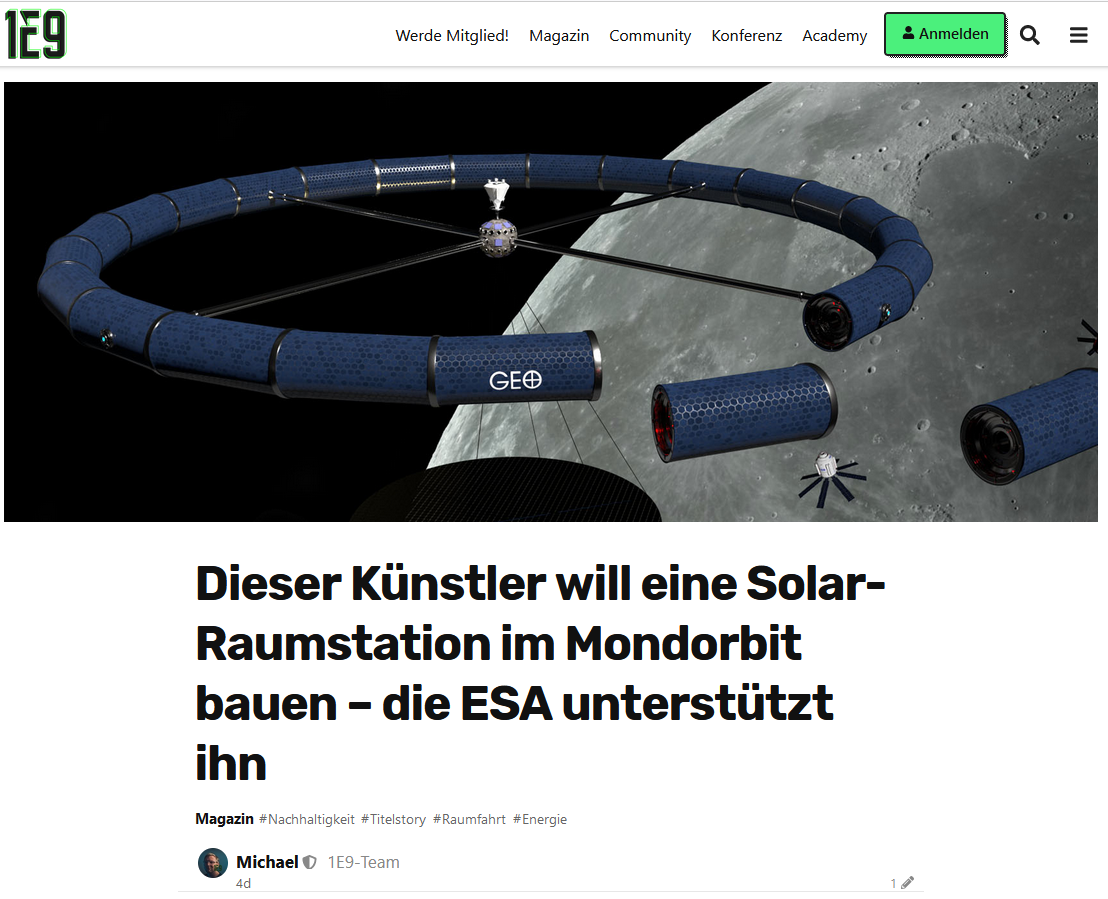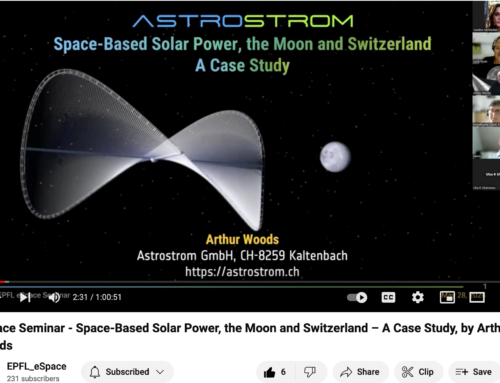English translation:
This artist wants to build a solar space station in lunar orbit – ESA supports him.
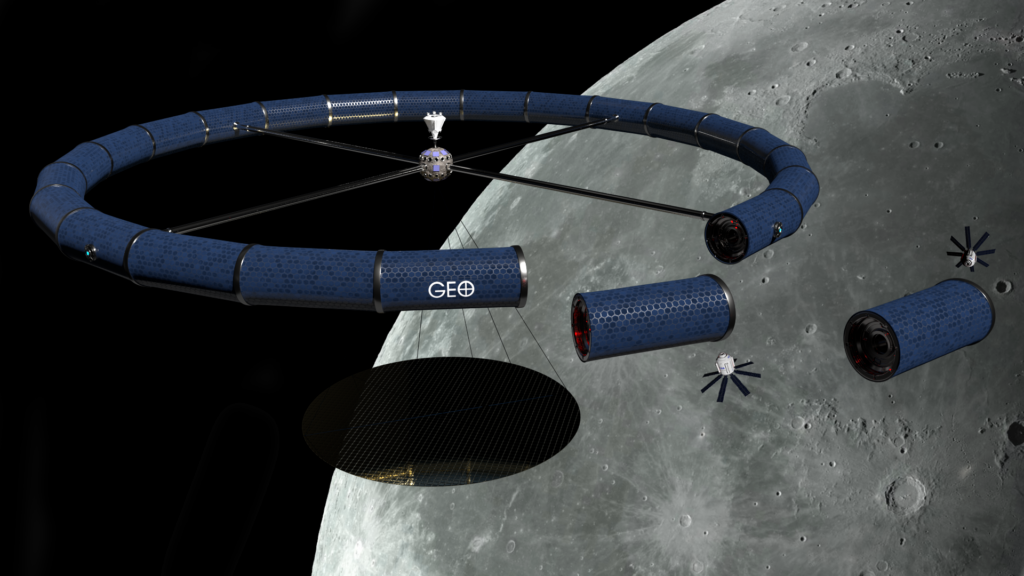
GE⊕-LPS – Greater Earth Lunar Power Station assembly in lunar orbit.
A new race to the Moon has started. But this time, different nations want to go to the moon and then stay there. Research stations and ‘moon villages’ are planned. They have to be powered. One solution comes from Switzerland: a start-up wants to design a space station encased in solar panels that sends clean electricity to the surface. The concept is being funded by ESA – and could eventually be used for Earth.
By Michael Förtsch
Its surface is grey, quite dusty and stony. In addition, with temperatures ranging from 130 degrees Celsius to -160 degrees Celsius, it can be deadly hot or cold. Still, after decades, the moon has come back into focus. Scientific as well as economic interest have sparked a new race. The US wants to put the first woman on the moon with the Artemis program and build a permanent establishment on the surface. Russia and China want to build a joint station on the moon. The European Space Agency ESA even dreams of a Moon Village that will be operated and used by different nations of the world – and could become a stepping stone to Mars and the other planets in our solar system. Some of these ambitious plans are expected to start before the end of this decade.
However, building a station on the moon alone is not enough. It must also be permanently operable – and for this you need one thing above all: electricity. China is therefore considering transporting small nuclear reactors to the lunar surface. Far safer, however, would be solar energy, which of course only flows when the panels are exposed to sunlight. However, Arthur Woods sees this as an interesting challenge rather than a problem. The artist, who was born in the USA in 1948 but has lived in Switzerland for several decades, knows space. He grew up not far from the Kennedy Space Center in Florida, and in 1993 his sculpture Cosmic Dancer traveled to the Russian space station Mir. Two years later he organized with Ars Ad Astra the first art exhibition in Earth orbit and has since been involved in numerous studies related to space travel.
“There are no sustainable terrestrial energy options sufficient to power our society.”
Arthur Woods
With his start-up Astrostrom, Arthur Woods now wants to solve the energy problems of the world and its future outposts on other celestial bodies. Or at least try. Because: “There are no sustainable terrestrial energy options that are sufficient for the energy supply of our society,” says Woods in an interview with 1E9. He sees the extraterrestrial solution in space-based solar power: in solar power plants floating in space. Since there is no atmosphere in space that weakens solar radiation and the power plants can always be positioned ideally in relation to the sun, they could generate electricity 24 hours a day. This would make them significantly more effective than any solar power on the surface of the earth could ever be. Using microwave or laser beams, the energy would then be sent to where it is needed.
Is it finally possible now?
The idea of solar power plants in space is by no means new, but rather very old . The Russian author and inventor Konstantin Eduardowitsch Ziolkowski presented the concept as early as the beginning of the 20th century. Around 30 years later, the author Isaac Asimov published a story in which he describes a solar power plant in space. Since then there have been repeated attempts by space agencies and private companies to turn this idea into reality and to make cheap electricity from space a reality. In most cases, gigantic surfaces and funnel structures made of solar panels were proposed, which should be pushed in front of the sun. Arthur Woods’ idea is a little different.

Lunar materials should also be used for the construction of the rings and the central habitat. These include the mineral-rich rock on the moon, which is said to be good as an insulator against cosmic rays
Together with the renowned architect Andreas Vogler, who has already designed bullet trains, churches and lunar bases, Woods dreamed up the plan for a space station in orbit around the moon. The Greater Earth Lunar Power Station – or GEO-LPS – is basically similar to early NASA space station concepts. In concept art, it looks like a giant donut that is constantly rotating, simulating gravity in the rings. However, the structure of the GEO-LPS, which consists of barrel-like components, should be clad all around with solar panels – and between which a fan of solar fans could be raised.
At the center, connected by long tubes, is said to be a central habitat, consisting of a sphere of disguised lunar material, where astronauts and tourists arrive. After all, according to Woods and Vogler, the power plant should more or less represent a holiday resort. A concept plan contains ring segments in which golf courses, parks, hotel rooms, wellness centers and greenhouses are to be accommodated. Almost incidentally, the electricity is to be generated with the huge solar panels and beamed to a receiver on the lunar surface with a wide microwave antenna .
“Many of the concepts on which our project is based were developed by great scientists and engineers in the 1960s and especially in the 1970s, during the oil crisis of the last century.“
Andreas Vogler
“Many of the concepts on which our project is based were developed by great scientists and engineers in the 1960s and especially in the 1970s, during the oil crisis of the last century,” says Andreas Vogler in an interview with 1E9. “Back then, space travel was still in its infancy.” Many concepts that were impossible at the time could be implemented today or at least soon. They now appear in a new light as a result of “technological, ecological and economic developments” over the past 20 years. This would not only affect the station itself, but also how it should be constructed.
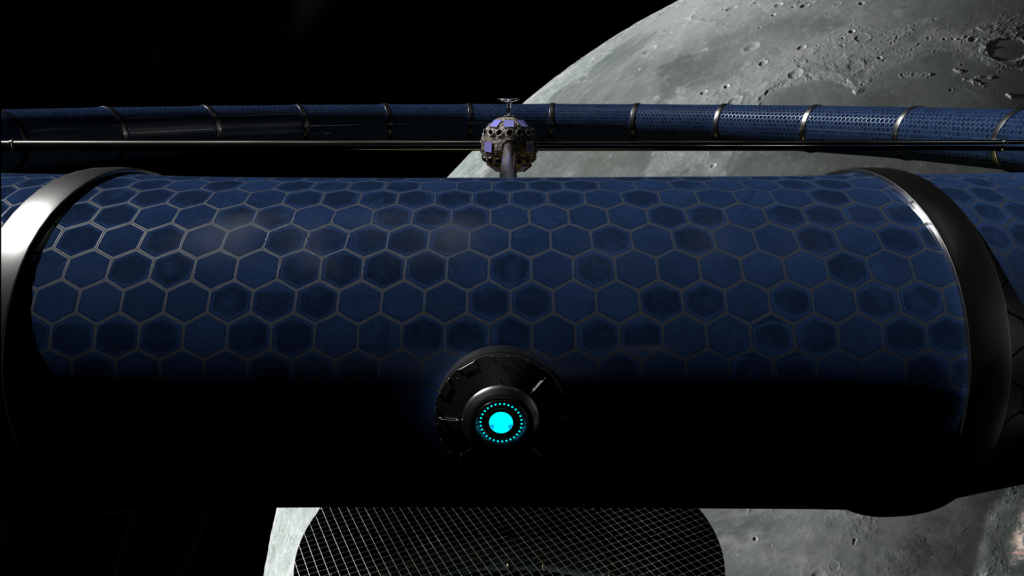
The exact dimensions for the solar space station are not yet available. But the segments should be large enough to accommodate hotels and greenhouses.
If Woods and Vogler have their way, at least parts of the station should be manufactured with resources that can be harvested and processed on the moon. Among other things, the solar cells themselves. Because silicon, aluminum and iron could be extracted from the moon rock. Glass can also be manufactured with high temperatures on the moon. In theory, you wouldn’t need a human for that. Robots could do this work fully automatically. For assembly, the components could then be fired into the orbit of the moon with a kind of space catapult. These ideas are not new either; some of them were debated at NASA decades ago..
It takes time
The idea of a solar space station in lunar orbit that supplies bases on the surface with huge amounts of electricity: it still sounds pretty much like science fiction. Woods cannot yet answer in detail whether, when and how the GEO-LPS will be feasible. It is also not yet possible to say how much electricity it could generate. There are “ideas and estimates,” he says. But a lot also depends on factors that are not yet known. These include, for example, what type of solar cells can be manufactured with the resources available on the moon and how the technology will develop over the coming years.
In addition, Woods and Vogler admit that there are of course still challenges and questions that have led to criticism of the concept of space-based solar power for years. Among other things, that enormous amounts of energy are lost during transmission from the power plants to ground stations. “But we are moving here in the typical environment of a disruptive technology,” says Vogler. “Wireless transmission of energy needs work, of course, but compared to solar and wind energy on Earth, a Power Satellite provides the only form of solar energy that is available 24 hours a day and therefore does not require storage technologies such as batteries.”
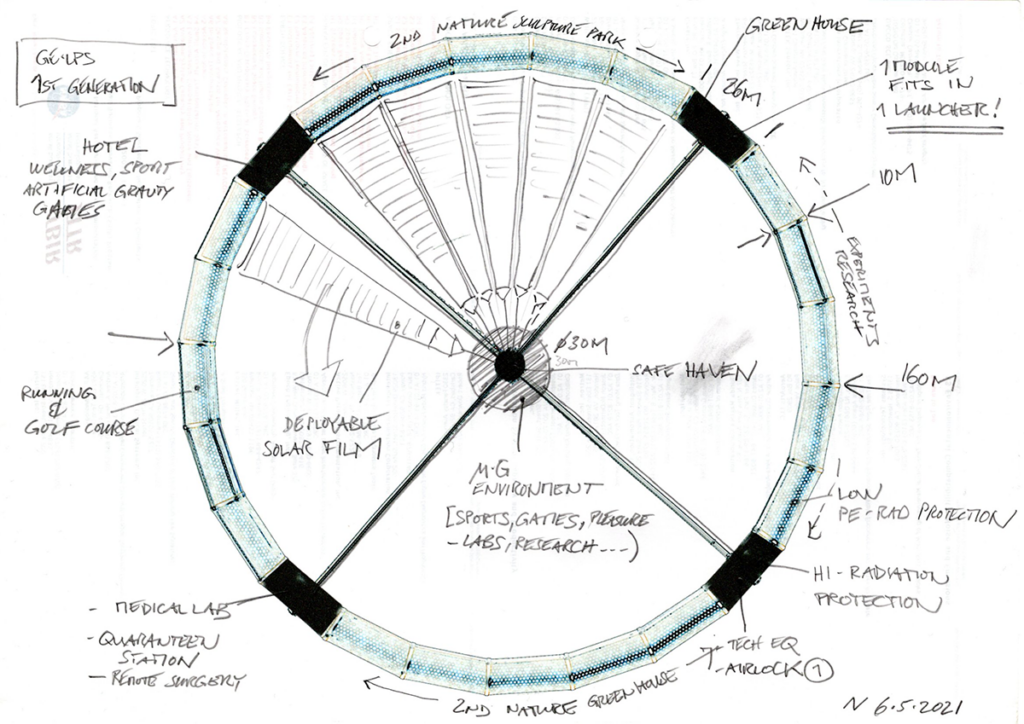
This sketch shows that a kind of fan made of solar film could also be stretched between the ring and the center.
For these reasons, too, Woods and Vogler’s plan has convinced the European Space Agency ESA, which intends to research the concept of solar power plants in space more intensively in the coming years. “We have been awarded a year-long contract to study the feasibility of generating solar power on the moon from lunar materials,” says Woods. For this purpose, studies are to be carried out at Astrostrom on how solar cells can be manufactured on the moon and then used. Woods is already in contact with numerous researchers who share his vision or who see it as a fascinating possibility.
“If we can prove that [ space-based solar power ] works, then [this technology] could also be used to generate clean energy for the Earth.“
Andreas Vogler
The space artist and the architect Andreas Vogler not only see huge potential in their own plan, but also in space-based solar power in general – and even a necessity if mankind is to advance further into space. “Several moon missions are planned for this decade, both robotic and with female astronauts,” says Vogler. “That’s why the situation is so critical.” Space, science and energy research could not afford to fall asleep again, as happened after the last landing on the moon. It is therefore necessary to start designing, researching and investing now. Also because all of this could eventually benefit the earth. “If we can prove that [with thespace-based solar power ] works,” says Woods, “then [this technology] could also be used to generate clean energy for the Earth.”
1E9 Denkfabrik GmbH, Spitzwegstraße 4, 81373 Munich
Michael Förtch
March 7, 2022
Original version in German:
Dieser Künstler will eine Solar-Raumstation im Mondorbit bauen – die ESA unterstützt ihn.
Es ist ein neues Wettrennen zum Mond entbrannt. Doch diesmal wollen verschiedene Nationen zum Erdtrabanten, um dann auch dort zu bleiben. Forschungsstationen und ‚Monddörfer‘ sind geplant. Die müssen mit Strom versorgt werden. Ein Lösungsansatz kommt aus der Schweiz: Ein Start-up will eine mit Solarpaneelen ummantelte Raumstation entwerfen, die sauberen Strom zur Oberfläche sendet. Das Konzept wird von der ESA gefördert – und könnte irgendwann für die Erde genutzt werden.
Von Michael Förtsch
Seine Oberfläche ist grau, ziemlich staubig und steinig. Dazu kann es mit Temperaturen von 130 Grad Celsius bis zu -160 Grad Celsius wahlweise tödlich heiß oder kalt werden. Dennoch ist der Mond nach Jahrzehnten wieder in den Fokus gerückt. Wissenschaftliche als auch wirtschaftliches Interesse haben ein neues Wettrennen entfacht. Die USA wollen mit dem Artemis-Programm die erste Frau auf den Mond bringen und eine dauerhafte Niederlassung auf der Oberfläche aufbauen. Russland und China wollen eine gemeinsame Station auf dem Erdtrabanten errichten . Die europäische Raumfahrtbehörde ESA träumt sogar von einem Moon Village, das von verschiedenen Nationen der Welt betrieben und genutzt werden soll – und zum Sprungbrett zum Mars und den anderen Planeten unseres Sonnensystems werden könnte. Die Anläufe für einige dieser ambitionierten Pläne sollen noch vor dem Ende dieses Jahrzehnts starten.
Eine Station auf dem Mond aufzubauen alleine genügt jedoch nicht. Sie muss auch dauerhaft betreibbar sein – und dafür braucht es vor allem eines: elektrischen Strom. In China wird daher darüber nachgedacht, kleine Kernreaktoren auf die Mondoberfläche zu transportieren. Weitaus sicherer wäre jedoch Solarenergie, die natürlich nur fließt, wenn die Paneele im Sonnenlicht stehen. Darin sieht Arthur Woods jedoch weniger ein Problem als vielmehr eine interessante Herausforderung. Der 1948 in den USA geborene, aber seit mehreren Jahrzehnten in der Schweiz lebende Künstler kennt das Weltall. Er wuchs unweit des Kennedy Space Centers in Florida auf, im Jahr 1993 reiste seine Skulptur Cosmic Dancer zur russischen Raumstation Mir. Zwei Jahre darauf organisierte er mit Ars Ad Astra die erste Kunstausstellung in der Erdumlaufbahn und wirkte seitdem an zahlreichen Studien rund um die Raumfahrt mit.
“Es gibt keine nachhaltigen terrestrischen Energieoptionen, die für die Energieversorgung unserer Gesellschaft ausreichen.”
Arthur Woods
Mit seinem Start-up AstroStrom will Arthur Woods nun die Energieprobleme der Welt und ihrer zukünftigen Außenposten auf anderen Himmelskörpern lösen. Oder es zumindest versuchen. Denn: „Es gibt keine nachhaltigen terrestrischen Energieoptionen, die für die Energieversorgung unserer Gesellschaft ausreichen“, sagt Woods im Gespräch mit 1E9. Die extraterrestrische Lösung sieht er in Space-based solar power: in Solarkraftwerken, die im All schweben. Da im Weltraum keine Atmosphäre vorherrscht, die die Sonnenstrahlung abschwächt und sich die Kraftwerke stets ideal zur Sonne positionieren können, könnten sie 24 Stunden am Tag elektrischen Strom generieren. Sie wären dadurch deutlich effektiver als es je ein Solarkraft auf der Erdoberfläche sein könnte. Mit Mikrowellen- oder Laserstrahlen würde die Energie dann dorthin gesendet, wo sie gebraucht wird.
Ist es jetzt endlich möglich?
Die Idee für Solarkraftwerke im All ist keineswegs neu, sondern bereits sehr alt . Schon Anfang des 20. Jahrhunderts legte der russische Autor und Erfinder Konstantin Eduardowitsch Ziolkowski das Konzept dar. Rund 30 Jahre später veröffentlichte der Autor Isaac Asimov eine Geschichte, in der er ein Solarkraftwerk im Weltraum beschreibt. Seitdem gab es immer wieder Anläufe von Raumfahrtagenturen und Privatunternehmen, diese Idee in die Wirklichkeit zu hieven und günstigen Strom aus dem All zur Realität zu machen. Meist wurden dafür gigantische Flächen und Trichter-Konstrukte aus Solarpaneelen vorgeschlagen, die vor die Sonne geschoben werden sollten. Die Idee von Arthur Woods sieht etwas anders aus.
Gemeinsam mit dem renommierten Architekten Andreas Vogler, der bereits Hochgeschwindigkeitszüge, Kirchen und Mondbasen designet hat, klügelte Woods den Plan für eine Raumstation im Orbit des Mondes aus. Die Greater Earth Lunar Power Station – oder auch GEO-LPS – gleicht grundsätzlich frühen Raumstationskonzepten der NASA. Sie sieht auf Konzeptbildern aus wie ein riesiger Donut, der stetig rotiert und dadurch in den Ringen eine Gravitation simuliert. Die aus Tonnen-artigen Bauteilen bestehende Struktur soll beim GEO-LPS jedoch rundherum mit Solarpaneelen verkleidet sein – und zwischen denen ein Fächer aus Solarfächern aufgezogen werden könnte.
Im Zentrum, angeschlossen über lange Röhren, soll sich ein zentrales Habitat befinden, das aus einer Kugel aus verkleidetem Mondmaterial besteht und an dem Astronauten und Touristen ankommen. Denn geht es nach Woods und Vogler soll das Kraftwerk mehr oder minder ein Urlaubsressort darstellen. In einem Konzeptplan finden sich Ringsegmente, in denen Golfkurse, Parkanlagen, Hotelzimmer, Wellness Center und Gewächshäuser untergebracht werden sollen. Fast schon nebenbei soll mit den riesigen Solarflächen der Strom erzeugt und mit einer breiten Mikrowellenantenne zu einem Empfänger auf der Mondoberfläche gebeamt werden.
“Viele der Konzepte, auf denen unser Projekt basiert, wurden von großartigen Wissenschaftlern und Ingenieuren in den 60er- und vor allem in den 70er-Jahren, während der Ölkrise im letzten Jahrhundert, entwickelt.“
Andreas Vogler
„Viele der Konzepte, auf denen unser Projekt basiert, wurden von großartigen Wissenschaftlern und Ingenieuren in den 60er- und vor allem in den 70er-Jahren, während der Ölkrise im letzten Jahrhundert, entwickelt“, sagt Andreas Vogler im Gespräch mit 1E9. „Damals war die Raumfahrt noch in Ihren Kinderschuhen.“ Viele Konzepte, die seinerzeit noch unmöglich waren, wären heute oder zumindest bald umsetzbar. Sie erschienen infolge von „technologischen, ökologischen und ökonomischen Entwicklungen“ der letzten 20 Jahre nun in einem neuen Licht. Das beträfe nicht nur die Station selbst, sondern auch wie sie konstruiert werden soll.
Geht es nach Woods und Vogler sollen zumindest Teile der Station mit Ressourcen hergestellt werden, die sich auf dem Mond ernten und verarbeiten lassen. Unter anderem die Solarzellen selbst. Denn Silizium, Aluminium und Eisen könnten aus dem Mondgestein extrahiert werden. Auch Glas lässt sich mit hohen Temperaturen auf dem Mond fertigen. Theoretisch bräuchte es dafür auch keine Menschen. Roboter könnten diese Arbeit vollautomatisiert erledigen. Zum Zusammenbau könnten die Bauelemente dann mit einer Art Raumkatapult in den Orbit des Mondes gefeuert werden. Auch diese Ideen sind nicht neu, sondern wurden teils schon vor Jahrzehnten bei der NASA debattiert.
Es braucht Zeit
Die Idee einer Solar-Raumstation im Mondorbit, die Basen auf der Oberfläche mit riesigen Mengen an Strom versorgt: sie klingt noch ziemlich nach Science Fiction. Ob, wann und wie die GEO-LPS machbar wird, das kann Woods noch nicht im Detail beantworten. Auch wie viel Strom sie erzeugen könnte, ließe sich jetzt noch nicht sagen. Es gebe „Ideen und Schätzungen“, sagt er. Aber viel hänge auch von Faktoren ab, die noch nicht bekannt sind. Darunter beispielsweise, welche Art von Solarzellen sich mit den vorhandenen Ressourcen auf dem Mond fertigen lassen und wie sich die Technologie in den kommenden Jahren weiterentwickelt.
Außerdem gestehen Woods und Vogler ein, dass es natürlich noch Herausforderungen und Fragen gibt, die schon seit Jahren zu Kritik am Konzept der Idee der space-based solar power führen. Unter anderem, dass bei Übertragung von den Kraftwerken zu Bodenstationen enormen Energiemengen verloren gehen. „Aber wir bewegen uns hier im typischen Umfeld einer disruptiven Technologie“, sagt Vogler. „An der drahtlosen Energieübertragung ist zu arbeiten, ganz klar, aber im Vergleich zu Solar- und Windenergie auf der Erde, liefert ein Power Satellit die einzige Form der Sonnenenergie, die 24 Stunden verfügbar ist und somit keine Speichertechnologien wie Batterien braucht.“
Auch aus diesen Gründen hat der Plan von Woods und Vogler überzeugt – und zwar die europäische Raumfahrtagentur ESA, die das Konzept der Solarkraftwerke im All in den kommenden Jahren stärker erforschen will. „Wir haben einen einjährigen Auftrag erhalten, um die Machbarkeit der Erzeugung von Solarenergie auf dem Mond aus Mondmaterialien zu untersuchen“, sagt Woods. Dafür sollen bei AstroStrom nun Studien durchgeführt werden, wie sich auf dem Mond Solarzellen fabrizieren und dann nutzen lassen. Dafür sei Woods bereits mit zahlreichen Forschern in Kontakt, die seine Vision teilen oder als faszinierende Möglichkeit erachten.
“Wenn wir nachweisen können, dass das [mit der space-based solar power ] funktioniert, dann könnte [diese Technologie] auch zur Erzeugung sauberer Energie für die Erde eingesetzt werden“
Andreas Vogler
Der Weltraumkünstler und der Architekt Andreas Vogler sehen nicht nur in ihrem eigenen Plan, sondern generell in space-based solar power riesiges Potential – und sogar eine Notwendigkeit, wenn die Menschheit weiter ins All vorstoßen soll. „In diesem Jahrzehnt sind mehrere Mondmissionen geplant, sowohl robotische als auch mit Astronautinnen“, sagt Vogler. „Deshalb ist die Situation so kritisch.“ Die Raumfahrt, die Wissenschaft und auch die Energieforschung könnten es sich nicht erlauben, nochmal einzuschlafen, wie es nach der letzten Landung auf dem Mond geschehen ist. Daher müsse jetzt begonnen werden, zu konzipieren, zu forschen und auch zu investieren. Auch weil all das irgendwann auch der Erde zugutekommen könnte. „Wenn wir nachweisen können, dass das [mit der space-based solar power ] funktioniert“, sagt Woods, „dann könnte [diese Technologie] auch zur Erzeugung sauberer Energie für die Erde eingesetzt werden.“
1E9 Denkfabrik GmbH, Spitzwegstraße 4, 81373 München
Michael Förtch
7. März 2022

